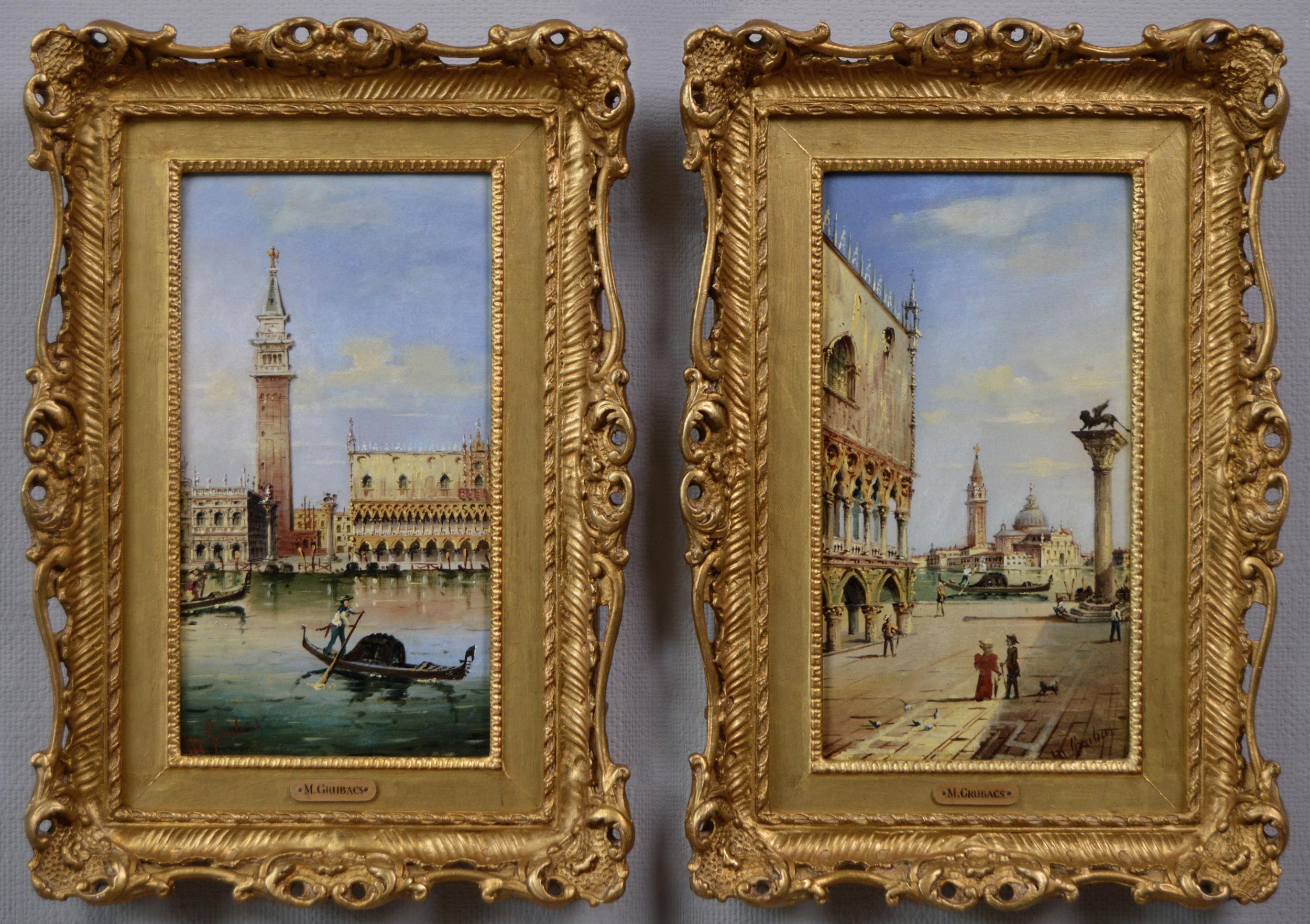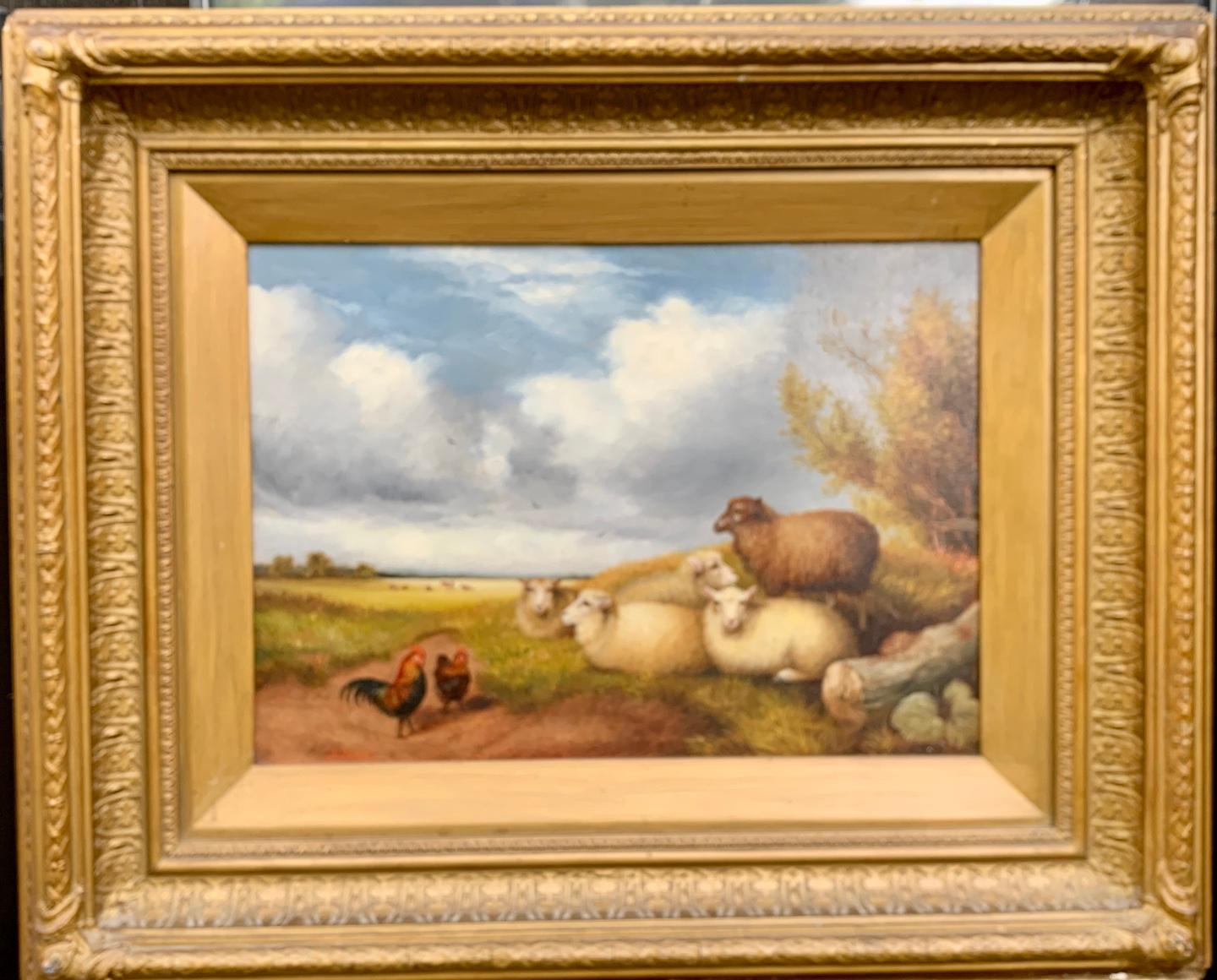Items Similar to Scalby Road, Scarborough, Moonlight Oil Painting, Grimshaw, 1874
Want more images or videos?
Request additional images or videos from the seller
1 of 2
John Atkinson GrimshawScalby Road, Scarborough, Moonlight Oil Painting, Grimshaw, 18741874
1874
About the Item
Oil on panel, signed and dated '1874' bottom left and entitled on reverse
Image size: 14 x 9 inches (35.5 x 22.75 cm)
Hand made gilt frame
Grimshaw's popularity, both in his lifetime and again today, was based on the evocative and atmospheric ‘moonlight’ paintings, such as this one, which he perfected during his Scarborough years. Indeed, four typical examples of Atkinson Grimshaw’s Scarborough ‘moonlight’ paintings are in the permanent collection at Scarborough Art Gallery. Grimshaw's long association with Scarborough began in the mid-1870s, when the artist rented a house in the town - which he named 'Castle-by-the-sea' after the Henry Longfellow poem. Scalby Road, the location of this work, was only an hour away from Grimshaw's home on foot. Unfortunately, in 1879 Grimshaw suffered a serious financial disaster and have to leave his beloved Scarborough and move away from the area.
John Atkinson Grimshaw
John Atkinson Grimshaw was born in Leeds, the son of an ex-policeman. Grimshaw first took up painting while he was employed as a clerk for the Great Northern Railway and by 1861, he had abandoned his job in order to devote all his time to becoming an artist. In his early work, he was influenced by John Ruskin’s creed of ‘truth to nature’ and adopted the detailed Pre-Raphaelite technique of the Leeds painter, John William Inchbold. He was also fascinated by the relatively new art of photography and may have used a camera obscura in developing his compositions.
Towards 1865, Grimshaw painted many urban scenes in which moonlight and shadows were the most striking features. The towns and docks that he painted most frequently were Glasgow, Liverpool, Leeds, Scarborough, Whitby and London. These works have become his best known although he also painted landscapes, portraits, interior scenes, fairy pictures and neo-classical subjects. Grimshaw painted mostly for private patrons. He exhibited five works at the Royal Academy in 1874, 1880, 1885 and 1886. He also exhibited at Sir Coutts Lindsay’s Grosvenor Gallery in 1885.
By 1870, Grimshaw had become successful enough to move to Knostrop Old Hall, a seventeenth century mansion about two miles from the centre of Leeds, which featured in many of his paintings. He rented another home near Scarborough which he called ‘The Castle by the Sea’, towards 1876. Grimshaw suffered a serious financial disaster in 1879 and had to leave his house at Scarborough. He moved to London from 1885-87 and rented a studio in Chelsea, leaving his family at Knostrop. He returned to Knostrop, where he died in 1893.
In 1858 at the age of 24 he married his cousin Frances Theodosia Hubbarde. Several of his children, Arthur Grimshaw (1864-1913), Louis H Grimshaw (1870-1944), Wilfred Grimshaw (1871-1937) and Elaine Grimshaw (1877-1970), became painters.
Museums and Galleries
Tate Britain, London, Bradford City Art Gallery, the Shipley Art Gallery, Gateshead, the Gloucester Museum and Art Gallery, the Bankfield Museum, Halifax, the Harrogate Museums and Art Gallery, the Ferens Art Gallery, Kingston-upon-Hull, the Leeds City Art Gallery, the Huddersfield Art Gallery, Kirklees Metropolitan Council, the Harris Art Gallery, Preston, the Walker Art Gallery, Liverpool, the Guildhall Art Gallery, the Scarborough Art Gallery, the Wakefield Art Gallery and Museums, the Pannett Gallery, Whitby, the Musée des Beaux-Arts, Brest, France, the Wadsworth Atheneum, Hartford, Connecticut, the Nelson-Atkins Gallery, Kansas City, Missouri, the Minneapolis Institute of Arts, Minneapolis, Minnesota, the Yale Centre for British Art, New Haven, Connecticut, the Museum of Art, New Orleans, Louisiana, the Rhode Island School of Design, Providence, Rhode Island in the United States, the Shepparton Art Centre, Welsford, Victoria, Australia.
- Creator:John Atkinson Grimshaw (1836-1893, British)
- Creation Year:1874
- Dimensions:Height: 9 in (22.86 cm)Width: 14 in (35.56 cm)
- Medium:
- Movement & Style:
- Period:
- Condition:
- Gallery Location:London, GB
- Reference Number:1stDibs: LU52414215142
About the Seller
5.0
Vetted Seller
These experienced sellers undergo a comprehensive evaluation by our team of in-house experts.
Established in 2007
1stDibs seller since 2014
63 sales on 1stDibs
Typical response time: 4 hours
- ShippingRetrieving quote...Ships From: London, United Kingdom
- Return PolicyA return for this item may be initiated within 14 days of delivery.
More From This SellerView All
- The River Thames at Twickenham, 19th Century English Oil paintingLocated in London, GBOil on panel Image size: 11 3/4 x 16 inches (30 x 40.5 cm) Original gilt frame, with old labels verso William Havell Havell was the son of a Reading drawing-master, and he partici...Category
19th Century Victorian Landscape Paintings
MaterialsOil, Panel
- Island of Gibraltar, Oil 19th Century LandscapeLocated in London, GBOil on canvas Image size: 8 3/4 x 12 1/2 inches (22 1/4 x 31 3/4 cm) Gilt frame This is a painting from the 19th Century depicts Gibraltar Island in Ohio, America, located within la...Category
19th Century Victorian Landscape Paintings
MaterialsCanvas, Oil
- David with the Head of Goliath, 19th Century Victorian OilBy John Rogers HerbertLocated in London, GBJohn Rogers Herbert RA 1810- 1890 Oil on canvas, dated '1850' lower right on sword strap Image size: 33 ½ x 23 ½ inches Gilt Watts frame This striking painting, depicts David as a y...Category
1850s Victorian Figurative Paintings
MaterialsOil
- The New Teacher, 19th Century Victorian Interior OilLocated in London, GBGeorge Bernard ONeil 1828-1917 Oil on canvas, signed & dated (18)76 lower right Image size: 22 ½ x 17 inches Original frame The painting depicts the arrival of the new teacher, a curious pupil peeps around a door to see her, while her friends look through the open door to the classroom to catch a glimpse. The artist has gone to great lengths with the painting, such as the highly detailed Dutch tiles on the bottom right of the picture or the window above the door in the background. O'Neil often painted works with several doorways leading off and giving a sense of depth to the work. The use of light and shadow is also cleverly depicted across the work, one light source arrives from where the viewer stands filling the room and the new teacher with light, while the other window above the door in the background also gives a warm glow. George Bernard O'Neill was born on 17th July 1828 in Dublin the ninth of fifteen children of Bernard and Sarah O...Category
1870s Victorian Landscape Paintings
MaterialsOil
- Autumn Gold, Betws-Y-Coed, Late 19th Century Victorian British OilLocated in London, GBJohn Brett 1831-1902 Autumn Gold, Betws-Y-Coed Oil on canvas, singed lower left Image size: 24 x 13 ½ inches Gilt frame John Brett ARA was an artist associated with the Pre-Raphaelite movement, mainly notable for his highly detailed landscapes. John Brett was an artist associated with the Pre- Raphaelite movement, mainly notable for his highly detailed landscapes Brett was born near Reigate on 8 December 1831, the son of an army vet. His sister Rosa Brett...Category
Late 19th Century Victorian Landscape Paintings
MaterialsOil, Canvas
- HMY VICTORIA AND ALBERT INSPECTING THE FLEET OFF PORTSMOUTH, maritime, shippingLocated in London, GBBRITISH SCHOOL 19th Century HMY VICTORIA AND ALBERT INSPECTING THE FLEET OFF PORTSMOUTH Oil on canvas, dated Image size: 22 ½ × 33 inches (57 ×84 cm) Contemporary gilt frame HMY Victoria and Albert was a twin-paddle steamer launched 25 April 1843. It functioned as a royal yacht of the sovereign, owned and operated by the Royal Navy. She was laid down in 1842 at Pembroke Dock and was designed by William Symonds. She measured 1,034 tons burthen, carried two guns, and was the first royal yacht to be steam powered, being fitted with a 430 horsepower engine. One of the notable features that distinguished the Royal Yacht from other paddle steamers of the time, was the extremely tall masts she carried. This was in order to fly the over-sized ensigns when Queen Victoria was onboard - the Royal Standard...Category
19th Century Victorian Landscape Paintings
MaterialsCanvas, Oil
You May Also Like
- Pair of 19th Century townscape oil paintings of VeniceBy Marco GrubacsLocated in Moreton-In-Marsh, Gloucestershire**PLEASE NOTE: EACH PAINTING INCLUDING THE FRAME MEASURES 15 INCHES X 10.5 INCHES** Marco Grubas/Grubacs Italian, (1839-1910) The Doge’s Palace, Venice & Piazza San Marco, Venice O...Category
19th Century Victorian Landscape Paintings
MaterialsOil, Panel
- Pair of landscape hunting scenes with wild boarLocated in Moreton-In-Marsh, Gloucestershire**PLEASE NOTE: EACH PAINTING INCLUDING THE FRAME MEASURES 17 INCHES X 20 INCHES** Godfrey Douglas Giles British, (1857-1941) Wild Boar & her Young in an Indian Landscape & Pursuit o...Category
Early 20th Century Victorian Animal Paintings
MaterialsOil, Panel
- 19th century English portrait of a dog with her PuppiesLocated in Woodbury, CTH.Jackson. 19th century English landscape with sheep English late 19th-century painter of animals either in barns or landscapes. His paintings have the influence of the work of the Belgium painter Cornelius van Leemputten...Category
1890s Victorian Animal Paintings
MaterialsOil, Panel
- 19th century Victorian English landscape with thatched cottage, figure at sunsetLocated in Woodbury, CT19th-century Victorian English landscape with a thatched cottage, and a figure at sunset A very fine and large example of O.T. Clark's work. Born in Hoxton, New Town (just north of...Category
1870s Victorian Landscape Paintings
MaterialsCanvas, Oil, Panel
- French 19th century Chickens in a barn or chicken coop interiorBy Charles-Emile JacqueLocated in Woodbury, CTFrench 19th century Chickens in a barn or Chicken coop interior Charles-Emile Jacque (23 May 1813 – 7 May 1894) was a French painter of animals ...Category
1870s Victorian Animal Paintings
MaterialsWood Panel, Oil
- French 19th century Chickens in a landscapeBy Charles-Emile JacqueLocated in Woodbury, CTFrench 19th century Chickens in a landscape Charles-Emile Jacque (23 May 1813 – 7 May 1894) was a French painter of animals (animalier) and engr...Category
1870s Victorian Animal Paintings
MaterialsOil, Wood Panel





